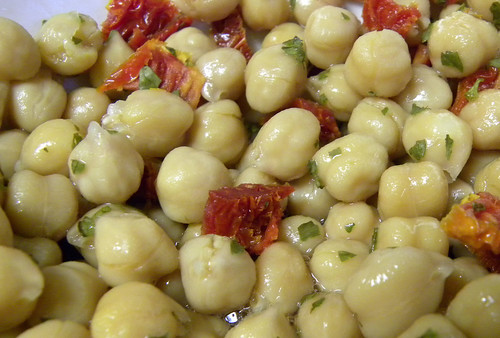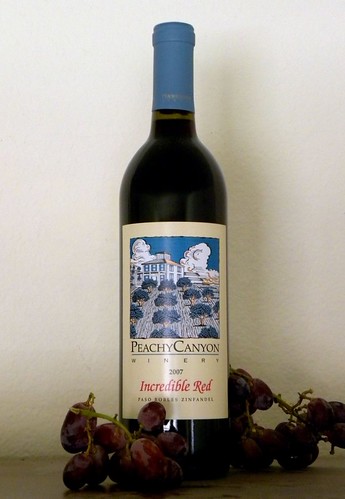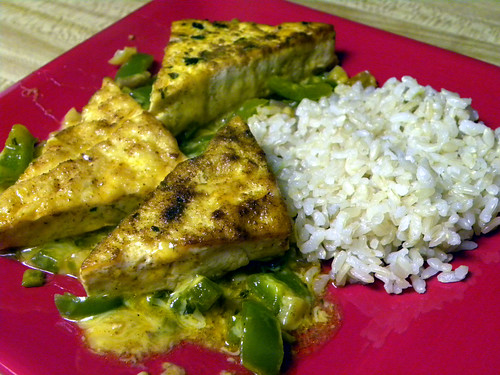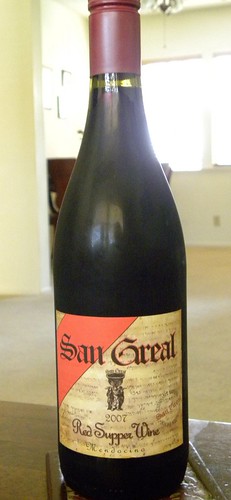
Sunday, May 30, 2010
Wine of the Week - Trader Joe's 2009 ZInfandel

Friday, May 28, 2010
Fake Your Way to Gourmet
For the last five years or so, I've been making a concerted effort to learn how to cook. Starting with the basics, I taught myself theories, recipes, methods, nutritional information, history. I'm still not a very good cook (if measured in breadth of abilities), but I've picked up a good working knowledge of the kitchen, and of the few differences between "home cooking" and "gourmet cooking". Most of them come down to work time, quality and diversity of ingredients, and level of theory, which are all fun to work on in your spare time. If you haven't got much spare time, however, you can add small, easy touches of gourmet flare to increase the appeal of your regular fare.
Sorry 'bout that. Saw it coming a mile away, but couldn't stop it.
On with the list!
1. This is the easiest trick: shallots. Instead of the onions called for in any recipe, substitute the same weight in shallots, or half-and-half it. Shallots have a subtler, tamer onion flavor, almost garlicky, and are an easy way to add a classy feel to a simple meal. Granted, they're twice the price of onions (or more), but that has more to do with the low demand/low production than with their delicateness. If you can grow onions, you can grow shallots.
2. More garlic! Whenever a recipe calls for "two cloves", add three or four. Your recipe calls for four cloves? Add six! Don't go too crazy, of course, but you can always at least double the garlic in a recipe.
3. Roast the garlic: almost as a side note to adding more garlic is roasting your garlic. It takes no effort (even less than mincing individual cloves), but does take an hour or so, so if time's a factor, skip to number four. If, however, you have the time but no inclination for work, try it! Take a whole bulb, cut off the top third or quarter (¾s of the cloves should be cut, but don't worry about trying to cut all of them), drizzle with olive oil, and stick it in a 375° preheated oven for an hour. Let cool, squeeze out (the cloves will have taken on a paste-like consistency), et voila! One roasted garlic bulb = 3 to 4 cloves unroasted, so it doesn't go as far, but who cares? Garlic's, like, 2¢ a clove.
4. Garnish with fresh herbs. Few care if you use dried or fresh herbs in the actual cooking, (and a few dried herbs, such as oregano, actually pack more flavor and nutrients into a smaller, easier to store package) but if you want to add a touch of gourmet to any meal, nothing beats garnishing with fresh herbs, like basil or sage. Here's an easy, difficult sounding technique (added bonus: it has a cool French name): - to 'chiffonade' (shif-oh-nahd'). That's where you stack up between 5-15 herb leaves, roll them into a cylinder, and slice 'em thinly with a sharp knife. When unrolled, it turns out you made a bunch of cool-looking ribbons! Adding fresh herbs is an easy way to fresh greens, a fresh flavor, and can make even cheesy enchiladas look suitable for Chez Charlie's.
5. Put down that 'vegetable'/corn/canola/rapeseed oil! A gourmet chef wouldn't be caught dead with that crap, except in their deep fryer, and if you have a deep fryer on your counter right now, you're probably... not... reading this blog. And it's not only those pressed oils' lack of flavor, either; the purported health benefits of cutting out saturated fats from our diets are not only bunkum, it's looking more and more like it's detrimental to our health.
The solution? Lard and butter. Cooking with lard or butter adds a layer of great flavor from the start, the lack of which in vegetable oil must be made up for, usually with more salt. Shallots sauteed in canola oil taste good, yes, because they're shallots. In olive oil, even better. But shallots sauteed in butter, until translucent and lightly brown? Those are heaven. And you know why your refried beans aren't nearly as good as that greasy Mexican joint's refried beans? You're using oil, and they're using lard. The sad fact is, that savory, creamy, melt-in-your-mouth goodness can only be achieved using lard. You can have great vegetarian refried beans (with butter), and passable vegan refried beans (usually using too much salt), but the only perfect refried beans are the ones made with lard.
Much of the satisfaction derived from eating butter- and lard-cooked foods is the effect of 'mouth feel'. See, it turns out, mouth feel is the fifth flavor* we Americans usually don't think about, but that, biologically, we desire at every meal, over and above all the others, at a deeply primitive level, mainly because it's the surest indicator to our brains of high amounts of essential amino acids.
Don't be afraid of fats! They're not just good, they're good for you! Your brain, especially, requires a steady intake of fat to rebuild and repair itself. As an added bonus, thanks to the presence of an actual flavor, butter and lard go farther than vegetable oils. You could probably cut the amount of fat called for in any recipe in half, as long as the original recipe calls for vegetable oil and you're replacing it with lard or butter.
You vegans and vegetarians out there, I know, you want my head on a platter. Wait, no, you're vegetarians, that's the opposite of what you want, but I agree, I've been focusing on animal-based fats. Sadly, that's because there're only two plant-based fats that come anywhere near lard and butter in consistency and flavor, and one of them, palm oil, is pretty bad for you. The other one? Coconut oil/butter will replace animal butter really well, and adds a nice mouthfeel.
So those are the easiest tricks of gourmet cooking, at least that I know. I left out a few of mine, because I wanted a nice list of five items (hint: balsamic vinegar is delicious in almost anything), but I don't really know enough to make a list of ten. One thing I have learned, and that maybe should be my Number One (except I really like that butter/lard angle): salt is a necessary component of all your meals, but for God's sake, don't make it the main flavor! Salt is like C-4: a little can do a lot of work for you, but any more than a little and you're standing in a pile of rubble that used to be your meal. It's also so omnipresent in any processed food that if you've eaten anything out of a box in the last week, you're all set. Salt is the perfect preservative (for the food industry): cheap, plentiful, goes with anything. The only thing that's turned out to be better than salt (for the food industry) is high fructose corn syrup.
*The other four being salt, sweet, bitter, and sour. Ayurvedic cooking says there are six essential flavors, all of which are necessary at each meal for true fulfillment.
Sorry 'bout that. Saw it coming a mile away, but couldn't stop it.
On with the list!
1. This is the easiest trick: shallots. Instead of the onions called for in any recipe, substitute the same weight in shallots, or half-and-half it. Shallots have a subtler, tamer onion flavor, almost garlicky, and are an easy way to add a classy feel to a simple meal. Granted, they're twice the price of onions (or more), but that has more to do with the low demand/low production than with their delicateness. If you can grow onions, you can grow shallots.
2. More garlic! Whenever a recipe calls for "two cloves", add three or four. Your recipe calls for four cloves? Add six! Don't go too crazy, of course, but you can always at least double the garlic in a recipe.
3. Roast the garlic: almost as a side note to adding more garlic is roasting your garlic. It takes no effort (even less than mincing individual cloves), but does take an hour or so, so if time's a factor, skip to number four. If, however, you have the time but no inclination for work, try it! Take a whole bulb, cut off the top third or quarter (¾s of the cloves should be cut, but don't worry about trying to cut all of them), drizzle with olive oil, and stick it in a 375° preheated oven for an hour. Let cool, squeeze out (the cloves will have taken on a paste-like consistency), et voila! One roasted garlic bulb = 3 to 4 cloves unroasted, so it doesn't go as far, but who cares? Garlic's, like, 2¢ a clove.
4. Garnish with fresh herbs. Few care if you use dried or fresh herbs in the actual cooking, (and a few dried herbs, such as oregano, actually pack more flavor and nutrients into a smaller, easier to store package) but if you want to add a touch of gourmet to any meal, nothing beats garnishing with fresh herbs, like basil or sage. Here's an easy, difficult sounding technique (added bonus: it has a cool French name): - to 'chiffonade' (shif-oh-nahd'). That's where you stack up between 5-15 herb leaves, roll them into a cylinder, and slice 'em thinly with a sharp knife. When unrolled, it turns out you made a bunch of cool-looking ribbons! Adding fresh herbs is an easy way to fresh greens, a fresh flavor, and can make even cheesy enchiladas look suitable for Chez Charlie's.
5. Put down that 'vegetable'/corn/canola/rapeseed oil! A gourmet chef wouldn't be caught dead with that crap, except in their deep fryer, and if you have a deep fryer on your counter right now, you're probably... not... reading this blog. And it's not only those pressed oils' lack of flavor, either; the purported health benefits of cutting out saturated fats from our diets are not only bunkum, it's looking more and more like it's detrimental to our health.
The solution? Lard and butter. Cooking with lard or butter adds a layer of great flavor from the start, the lack of which in vegetable oil must be made up for, usually with more salt. Shallots sauteed in canola oil taste good, yes, because they're shallots. In olive oil, even better. But shallots sauteed in butter, until translucent and lightly brown? Those are heaven. And you know why your refried beans aren't nearly as good as that greasy Mexican joint's refried beans? You're using oil, and they're using lard. The sad fact is, that savory, creamy, melt-in-your-mouth goodness can only be achieved using lard. You can have great vegetarian refried beans (with butter), and passable vegan refried beans (usually using too much salt), but the only perfect refried beans are the ones made with lard.
Much of the satisfaction derived from eating butter- and lard-cooked foods is the effect of 'mouth feel'. See, it turns out, mouth feel is the fifth flavor* we Americans usually don't think about, but that, biologically, we desire at every meal, over and above all the others, at a deeply primitive level, mainly because it's the surest indicator to our brains of high amounts of essential amino acids.
Don't be afraid of fats! They're not just good, they're good for you! Your brain, especially, requires a steady intake of fat to rebuild and repair itself. As an added bonus, thanks to the presence of an actual flavor, butter and lard go farther than vegetable oils. You could probably cut the amount of fat called for in any recipe in half, as long as the original recipe calls for vegetable oil and you're replacing it with lard or butter.
You vegans and vegetarians out there, I know, you want my head on a platter. Wait, no, you're vegetarians, that's the opposite of what you want, but I agree, I've been focusing on animal-based fats. Sadly, that's because there're only two plant-based fats that come anywhere near lard and butter in consistency and flavor, and one of them, palm oil, is pretty bad for you. The other one? Coconut oil/butter will replace animal butter really well, and adds a nice mouthfeel.
So those are the easiest tricks of gourmet cooking, at least that I know. I left out a few of mine, because I wanted a nice list of five items (hint: balsamic vinegar is delicious in almost anything), but I don't really know enough to make a list of ten. One thing I have learned, and that maybe should be my Number One (except I really like that butter/lard angle): salt is a necessary component of all your meals, but for God's sake, don't make it the main flavor! Salt is like C-4: a little can do a lot of work for you, but any more than a little and you're standing in a pile of rubble that used to be your meal. It's also so omnipresent in any processed food that if you've eaten anything out of a box in the last week, you're all set. Salt is the perfect preservative (for the food industry): cheap, plentiful, goes with anything. The only thing that's turned out to be better than salt (for the food industry) is high fructose corn syrup.
*The other four being salt, sweet, bitter, and sour. Ayurvedic cooking says there are six essential flavors, all of which are necessary at each meal for true fulfillment.
Thursday, May 27, 2010
Summer Sandwich - Tomato, Avocado & Basil
I made these sandwiches for our romantic picnic in Central Park a few weeks ago. On a baguette roll, layer thick slices of tomato, slices of avocado and whole basil leaves. Top with balsamic vinaigrette. Enjoy by gobbling down before you have time to snap a photo.
Tuesday, May 25, 2010
Garbanzos & Tomato Salad
Stole this recipe off of a bag of beans at the farmer's market. It's a great sidedish, or even a quick snack!

2 cups garbanzo beans
1/4 cup sundried tomatoes, chopped
2 tbsp olive oil
1 clove garlic, minced
1/4 cup red wine vinegar
1/4 cup red onion, diced
2 tbsp parsley
Mix vinegar, oil and garlic. Stir in the rest of the ingredients and marinate at room temp for about 1 hour, or refrigerate overnight.

2 cups garbanzo beans
1/4 cup sundried tomatoes, chopped
2 tbsp olive oil
1 clove garlic, minced
1/4 cup red wine vinegar
1/4 cup red onion, diced
2 tbsp parsley
Mix vinegar, oil and garlic. Stir in the rest of the ingredients and marinate at room temp for about 1 hour, or refrigerate overnight.
Sunday, May 23, 2010
Wine of the Week - Peachy Canyon 2007 Incredible Red Zinfandel
...But how incredible?

Another zinfandel from Paso Robles, whence my beloved Post-It Note wine comes. This wine has the peculiar characteristic of being almost flavorless up front, like drinking water. It makes up for it on the back end with peppery spices. Blooms well as it sits on the palate.

Another zinfandel from Paso Robles, whence my beloved Post-It Note wine comes. This wine has the peculiar characteristic of being almost flavorless up front, like drinking water. It makes up for it on the back end with peppery spices. Blooms well as it sits on the palate.
Thursday, May 20, 2010
Picnic Potato Salad

Picnics in Central Park are the main reason I moved to NYC. Okay, maybe not, but they're a pretty sweet perk. A recent, beautiful Saturday afternoon was made near-perfect by sandwiches, fresh fruit and this potato salad. Adapted from The Real Food Daily Cookbook, I made it without the tempeh to make it a simpler dish, but still just as yummy.
Recipe:
1 1/2lbs potatoes (I used mini red potatoes, because they're just so cute)
1/3 cup rice vinegar
1/6 cup olive oil
2 Tbsp dijon mustard
2 Tbsp maple syrup
salt
chopped celery, green onion and red onion
Boil or steam potatoes (cut up, of course) until soft. Meanwhile, whisk all of the dressing ingredients (not the veggies) together. When the potatoes are cooked, mix them in with the dressing and cool to room temp. Add the veggies and serve or keep in the fridge until it's time to leave for your picnic!
Tuesday, May 18, 2010
Lasagna Rolls
My fave way to make lasagna! Rather than baking a batch with all the same ingredient, these individual rolls allow you to customize. Everyone can get exactly what they want!

Bake the noodles according to package instructions.
Spread a thin layer of sauce on the bottom of a casserole dish.
Lay out each noodle and spread your ingredients on top. Roll up noodle from one end. Place in dish.
Top each noodle with a spoonful of sauce and sprinkle with cheese.
Bake covered (foil) for about 20 minutes. Remove cover and bake for 10 minutes more.

I call the one pictured above my Veggie Supreme Lasagna - Broccoli, cauliflower, carrots, butternut squash, eggplant, and spinach.


I call the one pictured above my Veggie Supreme Lasagna - Broccoli, cauliflower, carrots, butternut squash, eggplant, and spinach.
Monday, May 17, 2010
3 Versions of Bruschetta
Bruschetta is an idea, like Tapas, or Sushi. But as many of these food ideas go, 'bruschetta' the idea can be represented by 'bruschetta' the most common application of the term. Just like when you say 'sushi,' most everyone thinks of those inaccurate-yet-delightful seaweed-wrapped rice-fish-maybe-some-scallions-or-avocado baubles you get at the sushi bar, and when someone says 'tapas' you... well... tapas...
Bruschetta means an appetizer that's on bread, usually toasted. Its simplest form is slices of Italian or French bread drizzled with olive oil, maybe with some minced garlic, then grilled or broiled. Its best form, though, and the one that most people I've informally surveyed think of as 'bruschetta' is a delicious tomato-basil concoction that, frankly, is much more delicious than it has any right to be. I'll give youse guys three versions, with varying degrees of complication, the last one fanciest and possibly most delicious. But probably I just think that because it takes me the most time to make.
For all of these recipes, the method is the same: Mix ingredients, let sit for at least an hour, at most overnight. Preheat broiler to 450-500 degrees (you'll be monitoring closely, so temp isn't that important). Take a loaf of Italian or French bread and slice it crosswise, to about an inch thickness. Put the slices of bread into the oven/under the broiler unadulterated, then toast until very lightly golden; flip each slice, top them with a spoonful or two of the bruschetta mix, and pop back in the oven for... oh, 4-8 minutes.
First (pictured):
- 5-8 Roma tomatoes, diced*
- 2-4 cloves garlic, minced
- 1 large bunch basil**, shredded
- 1 Tbsp balsamic vinegar
- 1/8 to 1/4 cup extra virgin or virgin olive oil
- Sea salt and black pepper
Mix ingredients, let sit an hour or more in the fridge, then follow instructions above
Second:
- 5-8 Roma tomatoes, diced
- 2-4 cloves garlic, minced
- 1 large bunch basil, shredded
- 1/2 bunch parsley, chopped
- 1/2 large onion, minced, and probably sauteed until almost translucent
- 1 Tbsp balsamic vinegar
- 1/8 to 1/4 cup extra virgin or virgin olive oil
- 1 tsp sugar
- Sea salt and black pepper
Mix ingredients, let sit an hour or more in the fridge, then follow instructions above
Third:
- 2 Tbsp tomato paste
- 5-8 Roma tomatoes, diced
- 2-4 cloves garlic, minced; or 1 head garlic, roasted***
- 1 large bunch basil, shredded
- 1/2 bunch parsley, chopped
- 1 large shallot, minced and sauteed until almost translucent
- 1/2 Tbsp dijon mustard
- 2 tsp balsamic vinegar
- 1/8 to 1/4 cup extra virgin or virgin olive oil
- 1 tsp sugar
- Sea salt and black pepper
This one is only slightly different. The shallot should be sauteed, then allowed to cool. First mix together tomato paste, dijon, balsamic, olive oil, salt, pepper, and sugar. Then stir in the rest of the ingredients, let sit in the fridge for at least an hour, then follow instructions above.
*With tomatoes, you can do one of two things to prep them. You can 1. wash them and be done. Or you can 2. boil some water, dip each tomato in the boiling water for, like, a minute, and then peel the skin off of them. If you're making a sauce, like marinara, taking the skins off is recommended, so that the final texture is smooth, y'know, saucy. With this kind of thing, it's either/or. Skins = rustic and easy, no skins = fustic and smooth. Player's choice.
**This is pretty convenient nowadays, because of all the companies producing those horribly over-priced 'living herbs' packages, with the basil or mint or cilantro sticking out of a wad of growth medium. Basically, one of those things is a bunch, although you can easily stretch it to two bunches.
***To roast a head of garlic: Preheat oven to 400 degrees. Break off loose garlic-skin, then slice off the top third of the garlic head. Drizzle a little olive oil in a small pan, place the garlic head cut-side-down in the oil, then cover with foil and roast in preheated oven for thirty or forty minutes, until a knife easily pierces any clove. Then wait for the head to cool down and squeeze out all that delicious roasted goodness.
[Written by Matt, posted by May.. TEAMWORK!]
Sunday, May 16, 2010
Wine of the Week - Cellier du Rhone 2008 Rose Table Wine

I've had no previous experience with rosés, and this wine was probably not a good introduction - I didn't like it. If someone can recommend a more exemplary rosé, please let me know in the comments; I'd be interested in checking it out. Lesson learned after this week and last: distrust a wine described as "table wine." I know where to set the glass... now tell me what you really are.
The rundown on this wine: It has a rich pink appearance, with golden hues. The nose includes hints of lime. It tastes of pears and green apples, with an overtone of honey. As appealing as this may sound, I cannot recommend this wine.
Thursday, May 13, 2010
New York Coffee Cake

When Vegan Brunch came out, I was really excited to try out every single recipe. Then, morning sickness hit and I pretty much stopped cooking. Then I moved across the country and lived in my parents' basement for several months. We've finally moved into our own little slice of heaven in New York City proper, so it only seemed fitting that the first recipe I tried from the book be the New York Coffee Cake. I was skeptical that my cake would come out like the Entemann's cakes I ate growing up, but oh my word this cake was great. I brought it over to our Mother's Day celebration and barely got home with this one extra slice to photograph.

Tuesday, May 11, 2010
Hot and Spicy Tofu
Break out your spices because you'll be using all of them!
Though I'm sure this would work equally well with chicken, I kept semi-close to the receipe from This Can't Be Tofu. (Of course, if you're using chicken, make sure it's thoroughly cooked before serving!)

Though I'm sure this would work equally well with chicken, I kept semi-close to the receipe from This Can't Be Tofu. (Of course, if you're using chicken, make sure it's thoroughly cooked before serving!)

| To serve two: 1/2 brick of firm tofu 1 tsp paprika 1 tsp cinnamon 1 tsp cayenne pepper 1 tsp oregano 1 tsp cumin 1 tsp thyme 1 tsp black pepper Olive oil 1 green bell pepper, chopped 2 small chilies, chopped 1/4 cup onion, chopped 1-2 cups vegetable stock 2 cups brown rice, cooked | 1. Cut tofu into large chunks (I did triangles) and pat dry. 2. Mix spices together on a plate. Dip all sides of tofu in the spice mix. 3. Heat olive oil in a pan. Cook all sides of tofu until brown, ~10 minutes. 4. Remove tofu from pan. Without cleaning, add veggies and cook ~5 minutes. 5. Place tofu on top of veggies. Fill pan with veggie stock to that the veggies are covered and the stock is just touching the tofu. Cover and cook on low heat for about 15 minutes. Most of stock should evaporate. 6. Serve with rice! |
Sunday, May 9, 2010
Wine of the Week - San Greal 2007 Red Supper Wine

Wednesday, May 5, 2010
DIY Hummus

Hummus is one of the easiest 'gourmet' things you can make, and since there's no cooking involved (unless you want to cook your own beans, which is as foolproof a cooking endeavor as you can undertake; that way you can more easily control your sodium intake, as most canned beans are rife with salt), you cannot mess it up. Literally. In fact, most Mediterranean-style cooking is so easy as to be almost formulaic or intuitive, and once you get a few recipes under your belt, simple substitutions will enable you to multiply your repertoire three- or four-fold for each recipe, and add new nuances to old staples.
Hummus, with no cooking, goes like this:
- 1 can (14 oz) chickpeas/garbanzo beans (I know, at this point every can in the store says both "chickpeas" and "garbanzo beans," but the day I can no longer relevantly use the word "garbanzo" is the day my culinary soul... well, 'dies' is too strong an idea, but... definitely it will lose a finger)
- 1/4 cup tahini (sesame seed paste; your grocery store has it, just ask)
- 2-4 Tbsp extra virgin or virgin olive oil
- 2 cloves garlic, crushed or minced
- juice of 1 lemon (about 2 Tbsp; if you get more than that, reserve as needed)
- sea salt and pepper
- 1 Tbsp ground cumin or paprika, plus paprika for garnish
- minced herb for garnish (traditionally parsley, but basil, cilantro, anything but mint would work pretty well)
These pita are homemade, but I recommend you find a local middle Eastern bakery and buy 'em fresh. As satisfying as making your pita at home may be, you will never match the flavor and texture of one of those delightful local bakeries. Here in KC, we have Bethlehem Bakery and Jerusalem Bakery, which are the two most prominent. If we have ones not named after locales in the Holy Land, I don't know about them.
[This was posted by May, but written by Matt]
Tuesday, May 4, 2010
Orange Chocolate Cupcakes
As I have horrible luck veganizing cake/brownie mixes, I used a combination of two recipes: from Day to Day Wonderments and AllRecipes.com.

Cake Ingredients
1 1/2 cups flour
1 cup sugar
1/4 cup cocoa powder
1 tsp baking soda
1/3 vegetable oil
1 tsp vanilla extract
1 tsp distilled white vinegar
1 cup orange juice
Directions:
Preheat oven to 350 degrees. Prep cupcake pan.
Combine dry ingredients, then add the wet. Mix until smooth.
Fill cupcakes liners 3/4 full. Bake for ~30 minutes until a toothpick comes out clean.
Glaze:
4 cups powdered sugar
8 tbsp butter
4 tbsp orange juice
*Mix together until smooth

Cake Ingredients
1 1/2 cups flour
1 cup sugar
1/4 cup cocoa powder
1 tsp baking soda
1/3 vegetable oil
1 tsp vanilla extract
1 tsp distilled white vinegar
1 cup orange juice
Directions:
Glaze:
4 cups powdered sugar
8 tbsp butter
4 tbsp orange juice
*Mix together until smooth
Subscribe to:
Comments (Atom)





